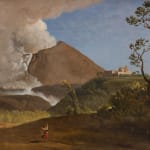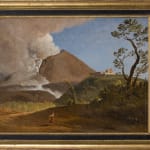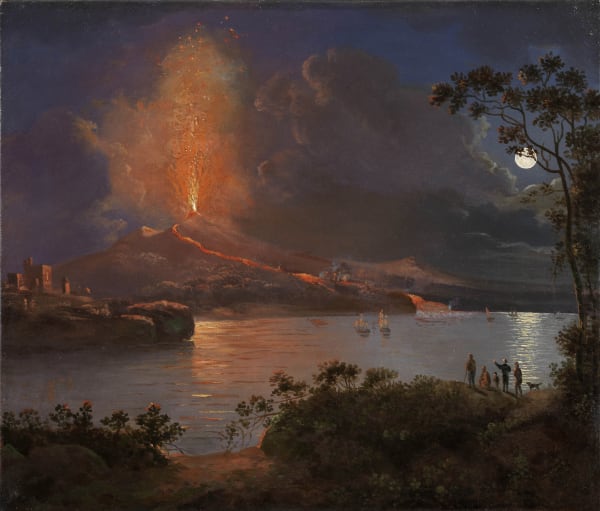-
Artworks


Simon DENIS (Antwerp 1755-Naples 1813)
The eruption of Vesuvius, 1804Oil on paper applied to cardboard
46 x 61 cm
60 x 74 x 4 cm (with the frame)
Dated lower right: 1804SOLDSimon-Joseph-Alexandre-Clément Denis took his first steps in the atelier of the landscape and animal artist Henri Joseph Antonissen (1737 – 1794) before settling in Paris around 1775 where he worked for Jean-Baptiste-Pierre Le Brun (1748 – 1813), a painter and painting dealer who financed Denis’ trip to Italy in 1786. In return, Denis undertook to find works of art for his mentor.[1] From that moment on, the artist would never leave Italy. In Rome, he married a young woman, Altomira Garavini, and joined the entourage of the eccentric Lord Bristol, Bishop of Derry (1730–1803), and William Hamilton (1731–1803), British ambassador in Naples. He was by this time a celebrated landscape painter, particularly affiliated with the French environment and especially Elisabeth Vigée-Le Brun (1755 – 1842), the wife of his former mentor, as well as François-Guillaume Ménageot (1744 – 1816) the then Director of the Académie Française. In 1803. he became an honorary member of the Accademia di San Luca and enjoyed wide renown in various artistic circles. Denis left the Eternal City sometime between 1801 and 1803 to settle in Naples where he lived until his death on January 1, 1813. In 1807, Joseph-Napoléon Bonaparte appointed him ‘First Painter of the Commission of Sites and Landscapes’, while in 1809 he obtained the Chair of Landscape at the Accademia di Belle Arti.In addition to the works intended for the Grand Tour's clientèle or made to satisfy royal or private requests, his production also included a body of works generally executed in oil on paper which bring out his quality as an en-plein-air painter. These studies, shown at the exhibition ‘Paysages d'Italie’,[2] reveal a freedom of execution and perspective that pays homage to the studies of Pierre-Henri de Valenciennes (1750 – 1819) who had returned to Paris in 1785 and whom Denis may well have known before his departure for Italy in 1786.The Eruption of Vesuvius presented here belongs to the latter category of works, and is of considerable interest not only for its aesthetic qualities but also because of the context in which it was developed. It depicts the paroxysm of the 1804 eruption, as evidenced by the date scored directly into the impasto on the far right of the composition. The volcano is seen from the south, with the buildings of the Hermitage of Camaldoli della Torre to its right on top of a hill (Fig. 1).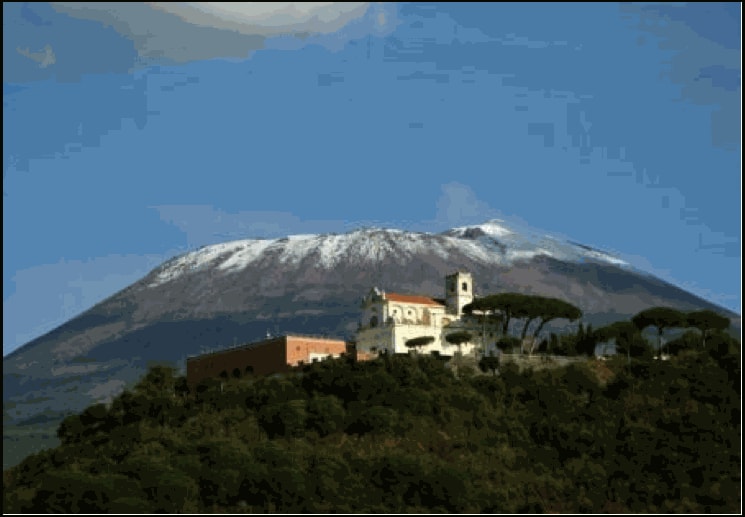 Fig. 1: Hermitage of the Camaldoli della Torre and Vesuvius (Naples)
Fig. 1: Hermitage of the Camaldoli della Torre and Vesuvius (Naples)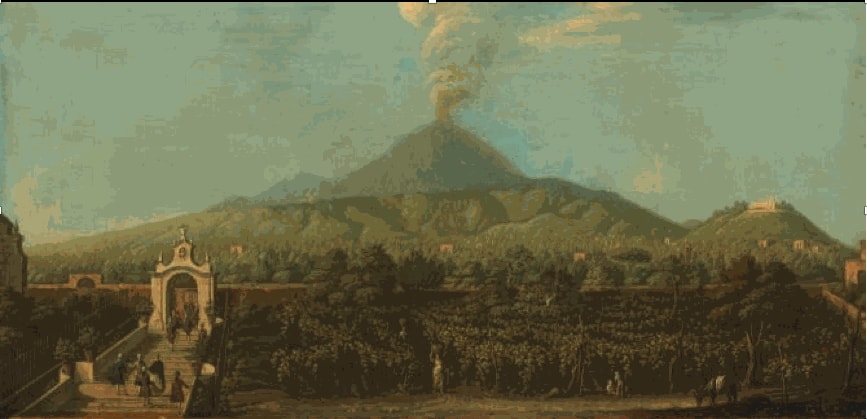 Fig. 2: Pietro Fabris (active in Naples between 1756 and 1803), Villa Angelica, 1779?This is the view that could be enjoyed close to Villa Angelica (fig. 2), the observatory used previously between 1776 and 1779 by Sir William Hamilton for the composing of his Phlegraean Fields, one of the founding texts of volcanological science. Nicola Filomarino, Duke of Torre, who was also present there at the time of the 1804 eruption, has given us a relatively detailed description.[1] The eruption began on August 11. The following day, he went to the territory of the Camaldoli where a vein of lava had come to a halt, to measure its temperature. This lava flow could correspond exactly, in our painting, to the still steaming lava flow that has run down the valley below the monastery. It has been established that Denis would use drawings, also ‘executed en plein air’, which he then integrated into his oil paintings, and it was probably in this way that the agitated young peasant woman visible in the foreground on the left came to life. The magnetic attraction exerted by this figure, tiny though she is, acts as a ‘visual counterpoint’[2] to the bulk of the column ‘of a frightening thickness’ that is rising from the erupting volcano, ‘the most terrifying and magnificent spectacle that Nature can provide’.[3] The image refers to an aesthetic of excess and the shadow created by the pointless haste of the peasant woman emphasizes the transience of human existence and reminds us of the unleashed omnipotence of Nature.
Fig. 2: Pietro Fabris (active in Naples between 1756 and 1803), Villa Angelica, 1779?This is the view that could be enjoyed close to Villa Angelica (fig. 2), the observatory used previously between 1776 and 1779 by Sir William Hamilton for the composing of his Phlegraean Fields, one of the founding texts of volcanological science. Nicola Filomarino, Duke of Torre, who was also present there at the time of the 1804 eruption, has given us a relatively detailed description.[1] The eruption began on August 11. The following day, he went to the territory of the Camaldoli where a vein of lava had come to a halt, to measure its temperature. This lava flow could correspond exactly, in our painting, to the still steaming lava flow that has run down the valley below the monastery. It has been established that Denis would use drawings, also ‘executed en plein air’, which he then integrated into his oil paintings, and it was probably in this way that the agitated young peasant woman visible in the foreground on the left came to life. The magnetic attraction exerted by this figure, tiny though she is, acts as a ‘visual counterpoint’[2] to the bulk of the column ‘of a frightening thickness’ that is rising from the erupting volcano, ‘the most terrifying and magnificent spectacle that Nature can provide’.[3] The image refers to an aesthetic of excess and the shadow created by the pointless haste of the peasant woman emphasizes the transience of human existence and reminds us of the unleashed omnipotence of Nature.
[1] As attested by a collection of twenty-one letters by Le Brun dated between 1797 and 1812, Sotheby’s sale, Monaco, 18-19 June 1992, no. 201, cited by Nicole Garnier-Pelle, Chantilly, Musée Condé, Peintures des XIXe et XXe Siècles, Inventory of French public collections, no. 42, Parisi, 1997, p. 135
[2] A. Ottani Cavina, Paysage d’Italie, les peintres du plein air, 1780 – 1830, Paris, Grand Palais (3 April – 9 July 2001), pp. 128-134
[3] Annales du Muséum d’Histoire Naturelle, Paris, 1804, vol. 5, p.448-461
[4] A. Ottani Cavina, Op. cit. Orage dans la campagne romaine note n° 82, p. 129
[5] H. Valenciennes, “Eruption d’un volcan”, Éléments de perspective pratique à l’usage des artistes suivis De Reflexions et Conseils à un élève sur la Peinture, et particulièrement sur le genre du Paysage ..., Paris, An VIII, p. 278
Join the mailing list
Subscribe to our newsletter to receive all the news about exhibitions, fairs and new acquisitions!


